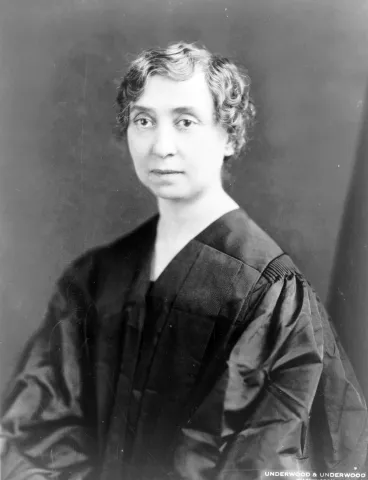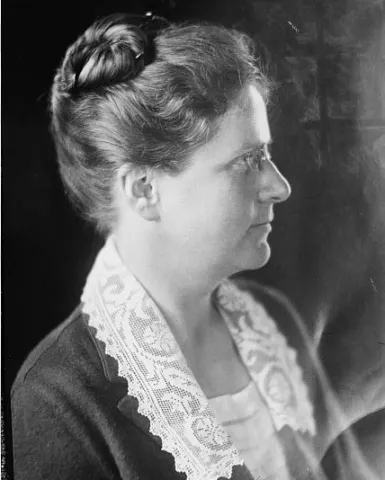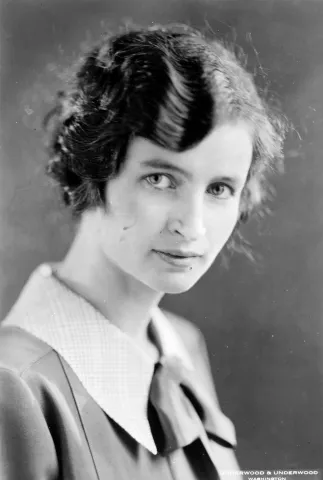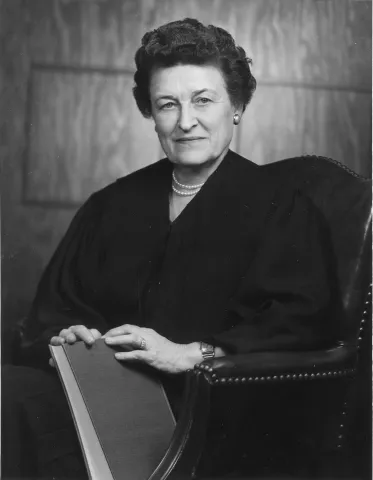It took nearly 140 years after the federal court system was established in 1789 before the first woman sat on a federal bench. Today, about one-third of all active Article III judges are women.
“If the first women judges were here today, they would rejoice at this achievement,” Justice Ginsburg said in a 1995 speech, noting that “their examples made it less difficult for the rest of us to gain appointment or election to the judiciary.” For Justice Ginsburg, these pioneer women judges were “way pavers” — in her words, “brave and bright woman who served as judges with extraordinary devotion and distinction.” In remarks published 20 years ago in the Fordham Law Review, Justice Ginsburg singled out a few of these women judges.
Learn about other female judges in the federal judiciary who have shaped legal history and inspired others to succeed.

Genevieve Rose Cline
Genevieve Rose Cline, although not on Justice Ginsburg’s list, was the first woman federal judge, nominated in 1928 by President Calvin Coolidge to the U.S. Customs Court (now known as the Court of International Trade.) She studied at Oberlin College, graduated with an LL.B. (Bachelor of Laws) degree from Baldwin-Wallace College in 1921, and entered private practice with her brother—who she credited with her early interest in the law. An active member of the Ohio Federation of Women’s Clubs, she was an early advocate for consumer protection, women’s rights, and the suffrage movement. Before becoming a judge, Cline became the first woman assigned by the U.S. Department of the Treasury to be the appraiser of merchandise at the port of Cleveland, Ohio. She served for 25 years on the U.S. Customs Court.

Florence E. Allen
Florence Allen, one of Justice Ginsburg’s “way pavers,” was the first woman to serve on an Article III federal appeals court. In 1909, she was the only woman in a class of about 100 in the University of Chicago Law School. She continued her studies at and graduated from New York University, which welcomed women and awarded them degrees even before the turn of the century. Denied the vote, she successfully defended a suffrage amendment in the City of East Cleveland before the Ohio Supreme Court. In 1919, Allen became an assistant prosecutor in Cuyahoga County, Ohio, the first female to hold that rank in the country. She was the first woman in the nation elected to sit on a court of general jurisdiction, and the first woman to serve on any state’s Supreme Court. In 1934 President Franklin Delano Roosevelt named Judge Allen to the U.S. Court of Appeals for the Sixth Circuit.

Burnita Shelton Matthews
Burnita Shelton Matthews, another “way paver” was appointed in 1949 by Truman to the U.S. District Court for the District of Columbia. She had attended law classes by night at what would become George Washington University, earning LL.B and LL.M degrees and becoming a Master of Patent Law. By day she worked at the Veterans Administration, and on weekends she picketed the White House, protesting for the right of women to vote. When she graduated from law school in 1920, no DC law firm would hire her—so she built her own practice. And when Matthews became a federal judge, she hired only woman as law clerks. In a 1984 commendation, President Reagan wrote, “[I]n furthering the administration of justice. . . [Judge Matthew’] diligence, distinguished efforts and pioneering spirit serve as an inspiration to all.”

Mary Honor Donlon
In the next decade, just one more woman, Mary Honor Donlon, would be appointed to the federal bench. Donlon was nominated by President Dwight Eisenhower in 1955 to the U.S. Customs Court to fill the seat vacated by Genevieve Rose Cline. Donlon earned her LL.B from Cornell Law School and went on to become, in 1928, the first woman partner at a Wall Street firm. She also served as chair of the New York State Industrial Board and chair of the New York State Workmen’s Compensation Board. In a 1955 Washington Post interview following her nomination to the bench Donlon said, “Up to now, not enough women have occupied these judicial positions—from which they could exert a great deal of influence for good.”
It wasn’t until 1961 that another woman was confirmed as an Article III judge.

Sarah Tilghman Hughes
Sarah Tilghman Hughes received a recess appointment to the U.S. District Court for the Northern District of Texas from President John F. Kennedy in 1961. The Senate confirmed her appointment in 1962. After graduation from Goucher College, Hughes began her professional career in 1919 in Washington, DC as a police officer working with prostitutes and runaway girls. She attended George Washington University Law School at night, commuting to the campus from her home, a tent near the Potomac River, and earning her LL.B in 1922. Hughes then entered private practice in Dallas, Texas. From 1931-1935, she also served as an elected Texas state representative, ending her legislative career to sit as a state judge from 1935-1961 on the Texas District Court. Following President Kennedy’s assassination, Hughes administered the oath of office to Lyndon B. Johnson, becoming the only woman in U.S. history to swear in a U.S. President.
Subscribe to News Updates
Subscribe to be notified when the news section is updated.
